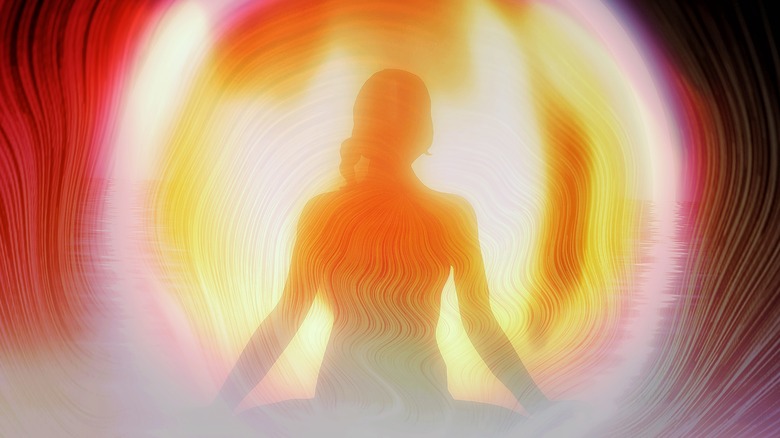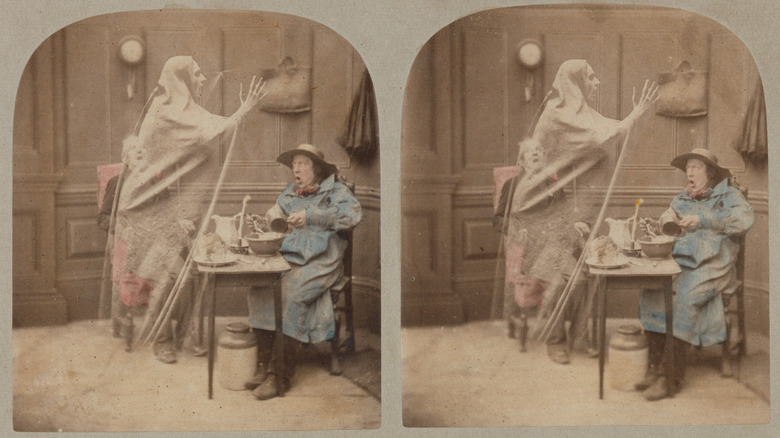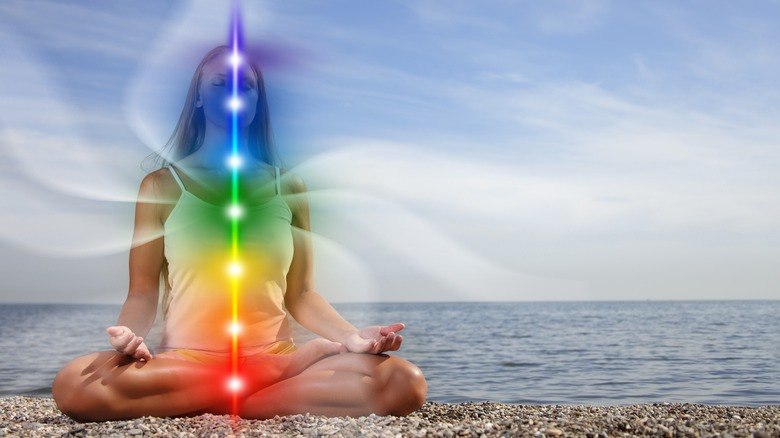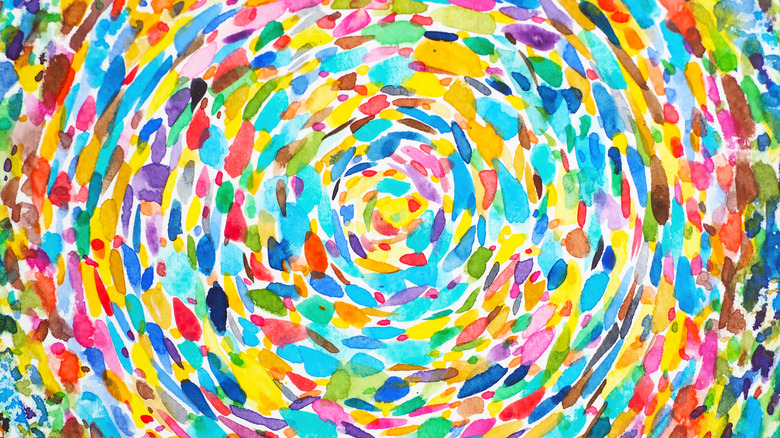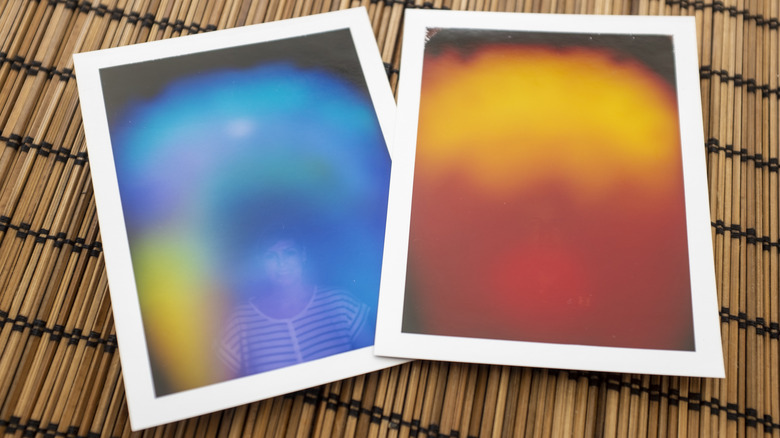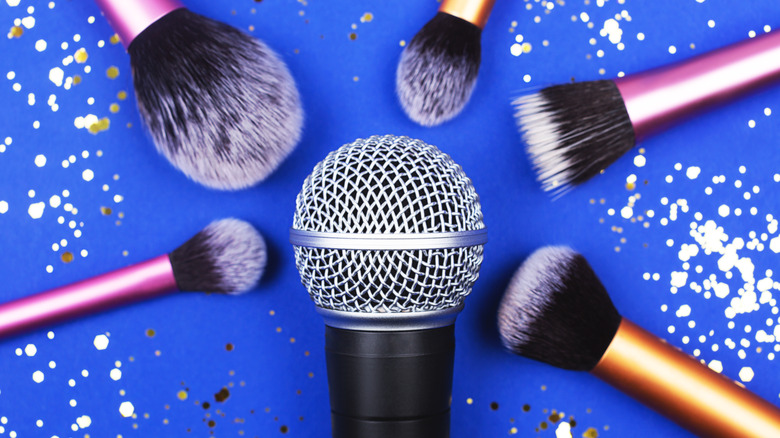The Truth About Auras According To Science
Bringing up the topic of auras in certain circles will likely provoke one of two opposite responses: 1) "Auras! What a load of bull," or, 2) "Oh, auras! You know, my friend had a reading and he had this bright red — like, really powerful — glow around him. Really beautiful." Thankfully, in between all the mysticism, crystal-clutching, and differently-colored photographic penumbras there's a real, honest-to-goodness scientific consensus on the whole matter: Nope.
For those unaware, auras — in the sense we're talking about them — don't refer to someone's unspoken vibe as they stroll into a bar or something. To the New Age-inclined, an aura is a visible outline of color that enshrouds the body and reveals certain personal characteristics. Red relates leadership and power, green denotes a nurturing person, indigo indicates the spiritually awakened, etc. And where do these auras apparently come from? Times of India relates a typical byline: "Every person and every molecule of his body emits energy. To be able to see that is simply about tuning in to a certain level of consciousness."
Such wording reveals why some believe in the reality of auras: They're spoken of in pseudoscientific terms that sound authentic enough to not be pure mumbo-jumbo. But what does "level of consciousness" mean to a neuroscientist? It's a medical term that describes someone's alertness, not a metaphysical descriptor. Ultimately, there's no data supporting the existence of auras, even when accounting for sensory-garbling conditions like synesthesia.
From the Victorian-era spiritualist heyday
Auras rode the wave of that heyday of whacky mystical experimentation and occult fascination: the Victorian era (1837 to 1901). The period saw profound technological and social changes overlap with the Industrial Revolution and radiate out from England through continental Europe as well as North America and Japan. Society reeled from the swift swap from agriculture to industry and felt crushed under inhumane working and living conditions. Many — including Queen Victoria herself — turned to alternative sources of spiritual fulfillment like seances, hypnotism, mediumship, clairvoyance, talking boards (like Ouija, a brand name), etc.
With new tech came new grifts, particularly those involving photography. Doubled-exposed photos from the 19th century revealed supposed apparitions hovering over the living, and mediums were snapped vomiting "ectoplasm" that was wadded fabric. In the 1890s Russian engineer Yakov Narkevich-Todko discovered that discharges of electricity from an electrode produced shapes on film. Come 1939 and Russian electrician Semyon Davidovich Kirlian stuck a leaf between an electrode and a film to produce such a shape, i.e., an "aura."
Kirlian and his leaf formed the foundation of aura prints, dubbed Kirlian photography. Despite the name, there's no actual photography involved — shapes and colors passively imprint on film as ionized air travels around an object. This Kirlian method hit Western countries in the early 1970s just in time to ride the New Age wave, which itself grew from Victorian beliefs systems like the East-meets-West metaphysics of Theosophy that petered off in the middle-ish 20th century.
The hues of bodily chakras
Without chakras there are no auras. Folks conceive of chakras as energetic focal points in the body that daisy-chain from the base of the spine up through the crown of the head. Each point is associated with a different color, from the basic biological needs of the root (red) chakra to the higher, cosmos-connected crown (violet) chakra. Believers tend to think of this system as an inherited, ancient Indian tradition derived from the Vedas, a spiritual text written from 1500 to 500 B.C.E. But the modern, seven-color system — and differently numbered arrangements — comes from the 1577 C.E. book, "'Explanation of the Six Chakras." This book got translated into English in 1918 right in the middle of Theosophy's boom.
Fast forward to the present and auras supposedly represent the precise features described by each chakra. Somehow "energy" — a badly-defined term — flows through the body, vibrates, and yields some nice, colorful patterns when captured using Kirlian photography. A reddish aura — in the spirit of the root chakra — describes a grounded person driven by bodily needs. A yellowish aura — related to the solar plexus chakra at the base of the sternum — portrays a purposeful, motivated, inquisitive person. There are also color combinations, blends, gradations, etc. According to the University of Austin, color differences in aura exposures relate to various dyes used on film.
Good art, bad science, decent therapy
At this point aura photography is a full-on boom business showing no signs of slowdown, as represented by legions of benignly-smiling photographic subjects arrayed in Instagram poses and encircled by colorful hues. Businesses like Radiant Human depict as much. Owner and portrait artist Christina Lonsdale says of aura photographs on Artsy: They "serve as a conduit for those seeking a new kind of self-exploration. Perceptions can pivot with the click of a shutter, illuminating our truest selves, and giving new light to what was there all along." Put differently, auras make good art but bad science. They're a snappy personality test meets self-therapeutic tool similar to Myers-Briggs Type Indicator (MBTI) online surveys or — depending on your mileage — Tarot card readings or astrological charts.
At a stretch, auras might serve some kind of semi-scientifically valid psychological purpose. As Very Well Mind explains, art therapy — which includes creative disciplines like dance and writing — is a perfectly legitimate therapeutic method. Granted, art therapy involves a patient actively making art, not just looking at pretty pictures. Nonetheless, few would deny the emotional and psychological benefits of much-loved artwork, music, literature, etc. Setting aside issues of scientific rigor for the moment, there are even businesses with their own apps like The Aura Power that incorporate all sorts of mystical goings-on into therapy sessions. This includes astrology, past-life regressions, and yes, auras. Such methods might not pass data-driven muster, but if they work, they work.
Misinformation galore
Part of the confusion about auras stems from that eternal wellspring of human misinformation and pseudoscience: the internet. There are many more chatty, hobbyist articles about auras online than hard scientific studies discussing their factuality. That's because no one in any scientific circle has ever taken Kirlian photography seriously as something meaningful. Metaphysics isn't physics, besides — by definition. But, we can still sniff out the scientific validity of auras by looking at the scientific literacy of the articles that discuss them. Such articles often openly state that auras are scientifically unproven and then commence to treating them as real, anyway.
For instance, Healthline says, "No scientific studies exist to prove the existence of auras," and commences discussing auras factually and with minimal disclaimers. The Centre for Excellence opts for the rhetoric, "Although science hasn't confirmed the existence of auras yet, this doesn't mean that they don't exist." It then cites Schumann resonances as indicative of the truth of auras, defining them as, "An energy field ... that is measurable, such as the Earth's electromagnetic field." But that's not what Schumann resonances are — they're frequencies at which the ionosphere bounces electromagnetic waves back to Earth, as Big Think details. They also have approximately zero to do with auras. Yet other articles like those on StyleCaster don't even bother to mention anything scientific and simply ask, "Have you ever wondered what your spiritual vibe looks like?" While marginally entertaining, such articles inherently perpetuate misinformation regarding the scientific validity of auras.
Research into synesthesia and OBEs
Some researchers have taken steps to try and explain auras — not the Kirlian photography type, because that's been long-shelved. Rather, they've looked into why some individuals claim to visually see auras. A study in Consciousness and Cognition investigated the relationship between aura-seeing and synesthesia, a condition where sensory data gets interpreted across senses. As Healthline explains, examples include "tasting shapes" or "hearing colors." But, the study concludes that "both phenomena [aura-seeing and synesthesia] are phenomenologically and behaviourally dissimilar."
Psychology Today also discusses the possibility that synesthesia produces visible auras, where aura seers "convert their impressions [of someone] into color." The article also says that LSD tends to conjure visions of auras along with talk of astral bodies and energy force fields both of which would be hallucinations. Additionally, the article says that those who experience OBEs — out-of-body experiences — often cite seeing aura-like glowing colors around things, but such sightings involve "imagination" and don't explain why auras only appear in close physical proximity to the viewer. Ultimately, the article concludes that visible auras might indicate a "misplaced body schema" in the one seeing them, i.e., a visual projection of one's own inner body map.
All this is to say what we already know: Auras have no scientific validity. If a person enjoys getting aura photographs done or reading articles about their apparent spiritual color, then great. So long as such people know that the whole thing is just entertainment.
